Condition Reporting – Paintings. Part III: Glossary – Canadian Conservation Institute (CCI) Notes 10/11
Introduction
This Note explains the terminology used by conservators in condition reports for paintings. It will help museum personnel write and maintain accurate condition report records. For detailed information on examination and condition reporting, refer to CCI Notes 10/6 Condition Reporting — Paintings. Part I: Introduction and 10/7 Condition Reporting — Paintings. Part II: Examination Techniques and a Checklist. Technical terms used in other CCI Series 10 Notes are also defined in this glossary.
Conventions used in the glossary:
- Terms are listed alphabetically.
- Terms are followed by their French translation and gender notation: “masc.” for masculine, “fem.” for feminine, “pl.” for plural.
- Terms within a definition that are in bold letters can be found as entries in the glossary.
- “Other term(s)” provides synonyms for the term being defined.
- “See also” refers to one or many related terms.
- “See” refers to the term under which the concept is defined.
- A French–English index, in alphabetical order of French terms, is provided at the end of this Note.
abrasion (abrasion, fem.)
Changes to part of the surface coating, paint layer or paint and ground caused by scraping, rubbing or over-cleaning with an abrasive product.
See also: rubbing, scraping, skinning, wear
accretion (accrétion, fem.)
An accidental deposit of “foreign” material that was not part of the painting process.
Note: Dried liquid residue, foodstuff or fly specks are examples of these types of deposits.
See also: grime, surface dirt
alligator cracks (pl.) (peau de crocodile, fem., or peau de crapaud, fem.)
Drying cracks that resemble the pattern of certain animal skins, such as an alligator.
Other term: alligatoring
See also: concentric cracks, cracks, diagonal cracks, drying cracks, feather cracks, mechanical cracks, spiral cracks, stretcher mark
alligatoring
See: alligator cracks
artist’s board (carton toilé, masc.)
A rigid support, usually paperboard, covered by a thin primed canvas.
Note: Canvas board is included in this category. Some paperboards are only primed and known as millboard and academy board.
See also: auxiliary support, composite support, rigid support, support
auxiliary support (support auxiliaire, masc., or support secondaire, masc.)
The framework over which a canvas is stretched.
Note: It usually refers to a stretcher or a strainer. It could also refer to a secondary support material such as a rigid board or stretched fabric that provides additional support to the primary support (see Figure 1).
Other term: secondary support
See also: artist’s board, composite support, cross bar, half-lap joint, mitre joint, mortise-and-tenon joint, rigid support, strainer, strainer bar, stretcher, stretcher bar, support, tongue-and-groove joint
backing board (dos protecteur, masc.)
A rigid board attached to the back of an auxiliary support or frame to protect the painting.
bevel (biseau, masc., or chanfrein, masc.)
Angled face of a stretcher or strainer bar (on the canvas side).
Note: A bevelled edge (see Figure 1) prevents the canvas from coming into contact with the stretcher bars when ground and the paint layer are being applied. In the long-term, it may also help to prevent a stretcher mark on the canvas or a crack from developing on the completed painting.
Other term: chamfer
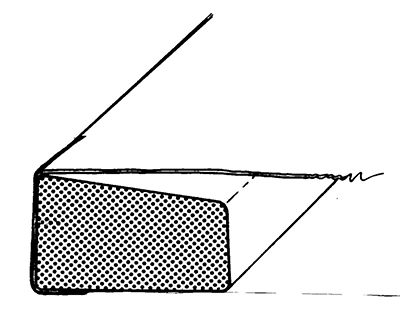
© Government of Canada, Canadian Conservation Institute. CCI 122428-0001
Figure 1. Cross-section of a bevelled auxiliary support (stretcher bar).
binder (liant, masc.)
The film-forming material that holds together the pigment particles in paint, such as drying oil in oil paint and vegetable gum in watercolour paint.
Other terms: binding medium, medium1
See also: paint, paint layer, pigment
binding medium
See: binder
blanching (blanchiment, masc., or chanci, masc.)
A localized, opaque, whitish discolouration in the paint or varnish layer. It can appear in spots on or in the surface of a painting or its coating.
Note: Blanching may occur when the binding medium in an oil film has been altered (e.g. by inappropriate cleaning) or when a varnish film has been degraded.
See also: bloom
bleeding (saignement, masc.)
The spreading of paint into adjacent areas of a painting.
Note: Bleeding may be intentional (caused by the artist) or unintentional (caused by water or solvent action).
blind cleavage (ampoule, fem.)
Cleavage that is hard to see or invisible between the layers of paint, between the paint layer and ground or between the ground and support.
Note: Blind cleavage may appear as a slight bulge in the paint surface.
See also: buckling, cleavage, cupping, flaking, incipient cleavage, lifting, tenting
blind lining
See: loose lining
blister (cloque, fem.)
A convex deformation of the ground, paint layer or surface coating creating a void between or within layers, often caused by excessive heat or humidity.
bloom (bleuissement, masc.)
A white, bluish-white or yellowish haze on the surface of a painting that is caused by components of the paint and ground migrating to the surface.
See also: blanching
buckling (soulèvement en tuile, masc.)
Lifting in the paint and ground layers in the form of ridges that is caused by pressure (compression).
Note: Buckling is often associated with cracks, cleavage and flaking. Buckling also occurs in some rigid supports (e.g. metal, paperboard).
See also: blind cleavage, cleavage, cupping, flaking, incipient cleavage, lifting, tenting
bulge (bosse, fem.)
A convex deformation involving the canvas, paint and ground layers.
Note: Bulges on the face of a canvas can be caused by blows to the back of an unprotected canvas. A bulge can also be caused by sustained pressure on the canvas, e.g. from debris lodged between the auxiliary support and canvas, from an object leaning against the back of the canvas or from extra material (e.g. excess glue) caught between a primary and auxiliary support.
See also: cockling, corner draws, dent
butt joint (joint abouté, masc.)
A joint formed by two lengths of wood meeting without any interlocking element cut into the adjoining pieces.
Note: Butt joints may be square-ended, with the end of one piece meeting the edge of the other at 90°. Butt joints may also be mitred, with both ends cut to meet at a 45° angle (see Figure 2).
See also: half-lap joint, joint, lap joint, mitre joint, mortise-and-tenon joint, strainer, stretcher, tongue-and-groove joint

© Government of Canada, Canadian Conservation Institute. CCI 122428-0003
Figure 2. Butt joint.
cami-lining (former des., avoid)
See: stretcher bar lining
canvas (toile, fem.)
A woven fabric painting support usually composed of one of the following natural fibres: linen, cotton, hemp, sometimes jute (burlap) or ramie, or mixtures of these materials.
Note: More recent canvases may be composed of synthetic fibres (e.g. polyester).
chalking (farinage, masc.)
A powdered deposit on a paint layer, caused by an insufficient amount of binding medium or weathering of paint from outdoor exposure.
chamfer
See: bevel
check (fissure, fem.)
A partial split along the grain or against the grain of a wood surface caused by too rapid drying or from repeated or severe fluctuations in humidity.
See also: split
chip (éclat, masc.)
A small amount of material (paint layer, ground or wood) that breaks away accidentally as a result of mechanical action.
cleavage (clivage, masc.)
A separation between layers of paint, between the paint layer and ground or between the ground and support.
See also: blind cleavage, buckling, cupping, flaking, incipient cleavage, lifting, tenting
cobweb cracks
See: concentric cracks
cockling (gondolage, masc., or ondulation, fem.)
A wavy deformation in the support, usually associated with works on paper.
Note: In paintings on canvas, cockling or rippling is often seen along the edges of a painting and may be the result of inadequate or uneven tacking of the canvas to the auxiliary support combined with relaxation of the materials of the painting and fluctuations in humidity.
Other term: rippling
See also: bulge, corner draws, dent
compo (composition, fem., or composé du doreur, masc., or mélange à mouler, masc., or pâte anglaise, fem.)
A mix of materials, traditionally hide glue, rosin, linseed oil and whiting (chalk or gypsum), that can be pressed and shaped to make moulded ornamentation on frames.
Note: Compo ornaments are applied on a frame’s wood surface and are often gilded.
Other term: composition
composite support (support composite, masc.)
A support composed of two or more materials, such as canvas (primary support) attached to cardboard (secondary or auxiliary support).
See also: artist’s board, auxiliary support, rigid support, support
composition
See: compo
compressed wood board (panneau de bois aggloméré, masc.)
A rigid panel engineered from wood fibres, particles or flakes that are compressed under heat and pressure with bonding agents such as wax, resin and other additives in order to produce specific properties for particular end uses.
Note: Compressed wood boards that have been most commonly used as painting supports are high-density fibreboards (hardboard), medium-density fibreboards (MDF) and low-density fibreboard, such as beaverboard. Particleboard is also a type of compressed wood board.
See also: hardboard, panel
concentric cracks (pl.) (craquelure circulaire, fem.)
Mechanical cracks in a roughly circular or cobweb-shaped pattern that are caused by a blow to or pressure on a painting.
Other term: cobweb cracks
See also: alligator cracks, cracks, diagonal cracks, drying cracks, feather cracks, mechanical cracks, spiral cracks, stretcher mark
corner cracks (pl.)
See: diagonal cracks
corner draws (pl.) (pli d’angle, masc.)
Ripples in a canvas radiating from the corners.
Note: Draws also develop along the edges of a painting where there is cockling. Draws occur during exposure to low relative humidity (e.g. during winter in cold climates with central heating) and may disappear when moderate relative humidity returns.
Other term: draws
See also: bulge, cockling, dent
crackle (pl.)
See: cracks
cracks (pl.) (craquelure, fem.)
Surface or deep checks in one or more of the varnish, paint or ground layers.
Note: Cracks are caused by a combination of mechanical forces and the response of the paint, ground and support layers to relative humidity fluctuations, periods of low relative humidity and low temperatures.
Other terms: crackle, craquelure
See also: alligator cracks, concentric cracks, diagonal cracks, drying cracks, feather cracks, mechanical cracks, spiral cracks, stretcher mark
cradle (parquetage, masc.)
A system of wooden or metal bars running horizontally and vertically in a grid pattern across the back of an artwork painted on a wood panel.
Note: Cradles were meant to prevent warping without restricting the natural expansion and contraction of the panel in response to changes in relative humidity.
craquelure (pl.)
See: cracks
crazing (faïençage, masc.)
A network of very fine cracks in a varnish, causing a loss of transparency.
Note: Crazing is associated with a brittle varnish layer.
cross bar (croisillon, masc., or traverse, fem.)
An extra horizontal or vertical piece added between the main bars to strengthen a strainer or a stretcher.
Other term: cross brace
See also: auxiliary support, half-lap joint, mitre joint, mortise-and-tenon joint, strainer, strainer bar, stretcher, stretcher bar, tongue-and-groove joint
cross brace
See: cross bar
cupping (soulèvement en cuvette, masc.)
Lifting in which islands of paint, separated by cracks, develop concave centres with raised edges, like shallow cups.
See also: blind cleavage, buckling, cleavage, flaking, incipient cleavage, lifting, tenting
cut (incision, fem.)
A severing of fabric or paper caused by a sharp instrument, leaving clean or sharp edges.
See also: puncture, tear
deformation (déformation, fem.)
A change in the original shape of a support, including bulges, depressions or cockling.
See also: warp2
dent (enfoncement, masc.)
A concave deformation (indent) on the surface of a material caused by a blow or by pressure from another object.
See also: bulge, cockling, corner draws
diagonal cracks (pl.) (craquelure en diagonale, fem., or craquelure d’angle, fem.)
Mechanical cracks often found at the corners of paintings and that can result from inappropriate keying out or from dropping the painting on its corner.
Other term: corner cracks
See also: alligator cracks, concentric cracks, cracks, drying cracks, feather cracks, mechanical cracks, spiral cracks, stretcher mark
draws
See: corner draws
drying cracks (pl.) (craquelure prématurée, fem.)
Cracks occurring during drying that can be wide, exposing paint layers or ground layers below, and that have rounded or sloping edges and no cleavage.
Note: Although frequently disfiguring, drying cracks are usually stable and do not spread.
See also: alligator cracks, concentric cracks, cracks, diagonal cracks, feather cracks, mechanical cracks, spiral cracks, stretcher mark
edge-strip (bordure de protection, fem.)
A thin protective strip of wood, metal or plastic attached to the sides of a painting and extending above the paint layers.
Note: Edge-strips on the four sides are used to isolate the paint surface from the rabbet or glazing2 of the frame (see Figure 3). However, in many circumstances using padding along the rabbet is now preferred.
See also: glazing, rabbet
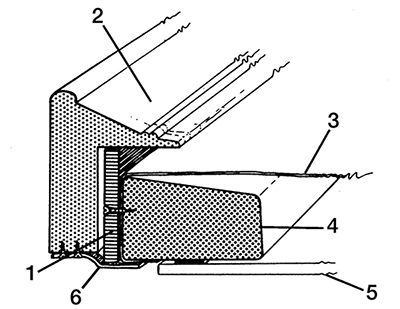
© Government of Canada, Canadian Conservation Institute. CCI 122428-0002
Figure 3. Cross-section of a framed painting with edge-strips: 1. edge-strip; 2. frame; 3. canvas; 4. auxiliary support; 5. backing board; 6. mending plate.
facing (cartonnage, masc., or facing [avoid, anglicism], masc.)
A reinforcing material, usually tissue paper, temporarily attached with adhesive to the surface of a painting in order to secure loose paint particles and protect the paint layer during certain conservation treatments.
feather cracks (pl.) (craquelure en épi, fem., or craquelure en arête de poisson, fem.)
Mechanical cracks in a pattern resembling a feather which are caused by a line of contact against the back of the painting (e.g. a scrape) or a glancing contact on the canvas with a hammer when keying out.
See also: alligator cracks, concentric cracks, cracks, diagonal cracks, drying cracks, mechanical cracks, spiral cracks, stretcher mark
fill (mastic, masc.)
Material replacing lost paint or paint and ground layers so that an area of loss becomes level with surrounding paint.
Other terms: filling, infill, infilling, luting
filling
See: fill
flaking (écaillage, masc.)
The partial or complete detachment of fragments of paint layers or ground from an underlying layer.
Note: Untreated flaking will result in the loss of paint layers and ground in the form of a lacuna.
See also: blind cleavage, buckling, cleavage, cupping, incipient cleavage, lifting, tenting
glaze (glacis, masc.)
A transparent layer (oil or resin-rich; usually pigmented) applied by an artist on the surface of a painting.
Note: The glaze can be composed of a single or multiple layers.
glazing1 (verb) (vitrage, masc.)
The action of fitting a protective sheet of glass or acrylic into a frame, separated from the painting by a liner, spacer or an edge-strip.
glazing2 (noun) (vitre de protection, masc.)
A protective sheet of glass or acrylic placed into a frame and separated from the painting by a liner, spacer or an edge-strip.
See also: edge-strip, rabbet
gouge (entaille, fem.)
The damage caused when material has been removed or dug out of a painting’s surface, support, auxiliary support, frame or another element of the artwork.
grime (encrassement, masc.)
A disfiguring deposit on or ingrained into the surface of a painting.
Note: Grime is often a combination of airborne soot, nicotine, cooking oils, smudges or finger and palm marks.
See also: accretion, surface dirt
ground (préparation, fem., apprêt, masc., or enduit, masc.)
An opaque white or coloured preparation layer applied to the support as a base for the paint layers.
Note: Grounds were traditionally composed of chalk or white lead combined with glue or oil. Today, grounds formulated with modern pigments and acrylic medium are common.
Other term: priming
half-lap joint (assemblage à mi-bois, masc.)
A type of lap joint where two wood pieces of equal thickness are made to fit together by reducing half the thickness of the wood at the joint site (normally a corner joint) and then overlapping the two thinned sections to produce a flush surface (see Figure 4).
Other term: halving joint
See also: auxiliary support, butt joint, cross bar, joint, lap joint, mitre joint, mortise-and-tenon joint, strainer, strainer bar, stretcher, stretcher bar, tongue-and-groove joint
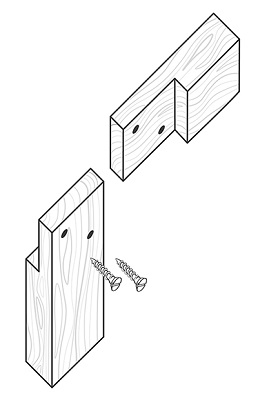
© Government of Canada, Canadian Conservation Institute. CCI 122428-0004
Figure 4. A half-lap joint.
halving joint
See: half-lap joint
hardboard (panneau dur, masc.)
A compressed wood board that has a density of 800–1200 kg/m3 and that can be smooth on one or both sides.
Note: Hardboard is commonly found under the name Masonite.
Other term: high-density fibreboard
See also: compressed wood board, panel
high-density fibreboard
See: hardboard
impasto (empâtement, masc.)
Paint standing in relief on the surface of a painting following pronounced brush strokes or the thick application of a layer of paint.
imprimatura (imprimatura, fem.)
A thin layer of paint applied over a ground by the artist to provide the base tone for the painting.
Other term: preparation layer
incipient cleavage (début de clivage, masc.)
A cleavage that is imminent and that often begins along the edges of cracks in the paint and ground layers.
See also: blind cleavage, buckling, cleavage, cupping, flaking, lifting, tenting
infill
See: fill
infilling
See: fill
inpaint (retouche1, fem.)
New paint applied on areas where original paint has been lost or abraded.
See also: inpainting, overpaint
inpainting (retouche2, fem.)
In restoration, the application of new paint on areas where original paint has been lost or abraded.
Note: “Retouching” used to sometimes mean inpainting, but it was also used to imply an unnecessary and damaging change to the original painting (overpainting). Today, the term “overpainting” is preferred for this concept.
Other term: retouching (former des., avoid)
See also: inpaint, overpaint
joint (joint, masc.)
The point of contact where two parts come together.
See also: butt joint, half-lap joint, lap joint, mitre joint, mortise-and-tenon joint, strainer, stretcher, tongue-and-groove joint
key (clé, fem., clef, fem., or coin, masc.)
A small piece of wood inserted into slots at the corners or joints of an auxiliary support to make the joints adjustable.
Other term: wedge
key out (régler la tension de la toile)
To expand a stretcher corner.
lacuna
See: loss
lap joint (joint à recouvrement, masc.)
A joint made at the intersection of two pieces of wood that are partially cut away so that they overlap smoothly when placed partly over one another (see Figure 4).
Note: How the cut is made and where the joint occurs determines the type of lap joint. Two examples include a joint at a corner where two planks meet at right angles (half-lap joint) and a joint near the middle section of one of the planks (cross lap joint).
See also: butt joint, half-lap joint, joint, mitre joint, mortise-and-tenon joint, strainer, stretcher, tongue-and-groove joint
lifting (soulèvement, masc.)
The partial detachment and elevation of fragments of paint or the paint layer and ground.
See also: blind cleavage, buckling, cleavage, cupping, flaking, incipient cleavage, tenting
liner (marie-louise, fem.)
The inside portion of a frame that borders a painting and is made separate from the frame.
Note: Liners are attached to the frame usually with nails or staples.
lining (rentoilage, masc., or doublage, masc.)
The process of providing a new fabric support to the back of a painting on canvas.
Note: This support may be attached to the original fabric support with adhesive or may just be in contact with it. Attaching a new fabric to the back of a painting that has previously been lined is called relining.
See also: loose lining, stretcher bar lining
loose lining (toile de soutien, fem.)
A fabric that is stretched directly behind, but not attached to, a painting on canvas and that provides additional support and protection to the painting.
Other term: blind lining
See also: lining, stretcher bar lining
loss (lacune, fem., or manque, masc.)
An area where paint or the paint layer and ground are missing because of damage or deterioration.
Other term: lacuna
luting
See: fill
marouflage (marouflage, masc.)
The process of attaching a canvas to a rigid surface (e.g. a wall, a panel).
mechanical cracks (pl.) (craquelure de tension, fem.)
Cracks that are caused by movement or excessive stress in various layers of a painting and that have sharp edges.
Note: Mechanical cracks may be distributed over a painting or may be restricted to one area associated with a blow or pressure to the back or front of the painting. These cracks are often described by the pattern they create.
See also: alligator cracks, concentric cracks, cracks, diagonal cracks, drying cracks, feather cracks, spiral cracks, stretcher mark
medium1
See: binder
medium2 (medium, masc.)
A substance mixed with paint to change certain characteristics (finish, texture, drying time or flow of the paint).
Note: Different types of mediums are used with each type of paint (acrylic, vinyl, oil, water).
Other term: painting medium
mending plate (plaque de renfort, fem.)
A custom-shaped narrow metal (normally brass) plate used to hold a painting in a frame.
Note: These are plates with a drilled hole at one or both ends; they are bent at angles to accommodate the projection of a stretcher or strainer beyond the back of the frame (see Figure 3).
mitre joint (assemblage à onglet, masc.)
A joint where the wood pieces are each cut at a 45° angle so that they meet to form a 90° angle (see Figure 5).
See also: auxiliary support, butt joint, cross bar, half-lap joint, joint, lap joint, mortise-and-tenon joint, strainer, strainer bar, stretcher, stretcher bar, tongue-and-groove joint
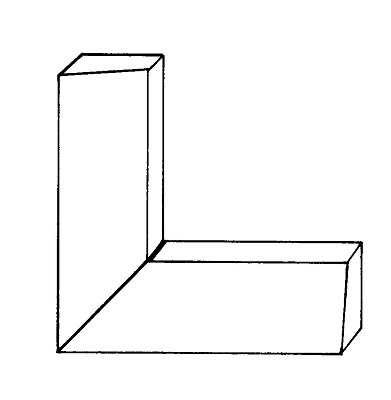
© Government of Canada, Canadian Conservation Institute. CCI 122428-0005
Figure 5. Mitre joint.
mortise-and-tenon joint (assemblage à tenon et mortaise, masc.)
A joint where a projecting wood piece (tenon) at the end of one piece of wood fits into a corresponding recess (mortise) cut into the end of the other piece of wood (see Figure 6).
Note: Unlike a tongue-and groove-joint, a mortise-and-tenon joint is visible.
See also: butt joint, cross bar, half-lap joint, joint, lap joint, mitre joint, strainer, stretcher, tongue-and-groove joint
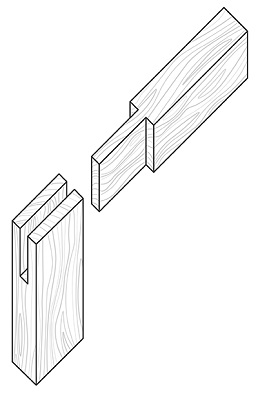
© Government of Canada, Canadian Conservation Institute. CCI 122428-0006
Figure 6. Mortise-and-tenon joint.
over-cleaning
See: skinning
overpaint (repeint, masc., or surpeint, masc.)
Paint that was not applied by an artist and that covers original paint.
Note: Overpaint was often used to change a painting’s image or to hide damage and usually covered more original paint than was necessary.
See also: inpaint, inpainting
paint (peinture, fem.)
A film-forming material composed of pigment or dye and a binder, such as oil, acrylic, resin, gum or glue.
See also: binder, paint layer, pigment
painting medium
See: medium2
paint layer (couche picturale, fem.)
One or several colour layers which make up the paint.
See also: binder, paint, pigment
panel (panneau, masc.)
A rigid primary or secondary support.
Note: Traditionally, a panel was a wooden board or a number of boards joined together. The term has now broadened to refer to wood-based supports, such as compressed wood boards and plywood. Other rigid materials, such as aluminium honeycomb-core supports and aluminium/polyethylene boards, can also be referred to as “panels.”
See also: compressed wood board, hardboard
pentimento (repentir, masc.)
An underlying design element seen through the surface paint layer, where an artist made a change in composition while painting that work of art.
Note: Oil paints become more transparent with age, so underdrawings or design elements executed in a preliminary composition may become visible.
Note: pentimenti: plural.
pigment (pigment, masc.)
Finely divided coloured particles that, when combined with a medium, form paint.
See also: binder, paint, paint layer
plain pattern
See: plain weave
plain weave (armure toile, fem.)
A weave pattern seen in canvas paintings where one weft thread is woven alternately over and under the warp threads (see Figure 7).
Other terms: plain pattern, tabby pattern
See also: twill weave, warp1, weave, weft

© Government of Canada, Canadian Conservation Institute. CCI 122428-0011
Figure 7. Plain weave.
powdering (pulvérulence, fem.)
Condition of a material that can be easily reduced to a powder.
preparation layer
See: imprimatura
primary support
See: support
priming
See: ground
puncture (perforation, fem., or trou, masc.)
A small hole through a painting.
Note: A deformation of the surface may accompany a puncture.
See also: cut, tear
rabbet (feuillure, fem.)
An L-shaped recess on the back of a frame in which a painting rests.
Note: “Padding the rabbet” usually refers to padding the part of the rabbet that is in contact with the surface of the painting or glazing (see Figure 8).
See also: edge-strip, glazing

© Government of Canada, Canadian Conservation Institute. CCI 122428-0008
Figure 8. Rabbet being padded.
retouching (former des., avoid)
See: inpainting
rigid support (support rigide, masc.)
A hard and/or inflexible support for a painting as opposed to a flexible fabric (canvas) support.
Note: Rigid support materials include panels, artist’s board, glass, ceramics and metals.
See also: artist’s board, auxiliary support, composite support, support
rippling
See: cockling
rubbing (frottement, fem.)
Repeated contact with a surface resulting in a compression or loss of material that changes its appearance, usually its gloss or its colour.
See also: abrasion, scraping, skinning, wear
scalloping
See: tension garland
scraping (grattage, masc.)
Repetitive abrasion by a sharp object or instrument that results in the loss or removal of one or more layers of material.
See also: abrasion, rubbing, skinning, wear
secondary support
See: auxiliary support
selvedge (lisière, fem.)
The original woven edge of a piece of fabric where the weft threads return over the warp threads.
Note: A selvedge usually is a tightly woven “finished” edge.
sight edge (mesure à vue, fem.)
The visible perimeter of a painting in a frame (see Figure 9).
Note: Term used when describing the locations and coordinates of areas of damage or alteration when a painting is examined in its frame.
Note: Not to be confused with the actual painting’s edge, which is hidden under the rabbet of the frame.

© Government of Canada, Canadian Conservation Institute. CCI 122428-0009
Figure 9. Sight edges.
size (encollage, masc., or colle, fem.)
A solution, emulsion or gel applied to raw canvas or another painting support before the ground layer is applied in order to protect the canvas fibres from the oil medium and reduce the absorbency of the support.
Note: Traditionally, skin glues, gelatin, gum or starch were used. Modern sizes include synthetic formulations.
Other term: sizing
sizing
See: size
skinning (épidermage, masc., or nettoyage excessif, masc.)
The abrasion of original paint by inexpert cleaning.
Note: Skinning often exposes an underlying ground layer. It also emphasizes the weave of the canvas on a thinly painted canvas.
Other term: over-cleaning
See also: abrasion, rubbing, scraping, wear
spiral cracks (pl.) (craquelure en escargot, fem., or craquelure en colimaçon, fem.)
Mechanical cracks in the shape of a spiral that are caused by release of stresses in the paint layers.
See also: alligator cracks, concentric cracks, cracks, diagonal cracks, drying cracks, feather cracks, mechanical cracks, stretcher mark
split (fente, fem.)
A complete break through a piece of wood along the grain.
See also: check
strainer (châssis simple, masc.)
An auxiliary support framework (usually wooden) with fixed corners, over which a canvas is stretched.
See also: auxiliary support, butt joint, cross bar, half-lap joint, joint, lap joint, mitre joint, mortise-and-tenon joint, strainer bar, stretcher, stretcher bar, tongue-and-groove joint
strainer bar (barre1, fem., or montant, masc.)
The main outer piece of a strainer.
See also: auxiliary support, cross bar, half-lap joint, mitre joint, mortise-and-tenon joint, strainer, stretcher, stretcher bar, tongue-and-groove joint
stress garland
See: tension garland
stretcher (châssis à clés, masc.)
An auxiliary support framework (usually wooden) with expandable corners, over which a painting canvas is stretched.
See also: auxiliary support, butt joint, cross bar, half-lap joint, joint, lap joint, mitre joint, mortise-and-tenon joint, strainer, strainer bar, stretcher bar, tongue-and-groove joint
stretcher bar (barre2, fem.)
The main outer pieces of a stretcher.
See also: auxiliary support, cross bar, half-lap joint, joint, mitre joint, mortise-and-tenon joint, strainer, strainer bar, stretcher, tongue-and-groove joint
stretcher bar lining (rentoilage sur barres, masc.)
Lining that does not require a painting to be removed from its stretcher or the use of adhesives.
Note: Lining fabric is inserted between a painted canvas and its stretcher’s crossbars, then stretched and attached to the back of the main (outer) stretcher bars.
Other term: cami-lining (former des., avoid)
See also: lining, loose lining
stretcher crease
See: stretcher mark
stretcher garland
See: tension garland
stretcher mark (marque du châssis, fem.)
A line of cracks or deformation in a painting’s surface that follows along the inside edges of the stretcher or strainer bars.
Note: The marks may result from repeated contact of the canvas with sharp-edged or inadequately bevelled stretcher or strainer bars or from the influence of the differing environments behind the canvas at the inner edges of the bars.
Other term: stretcher crease
See also: alligator cracks, concentric cracks, cracks, diagonal cracks, drying cracks, feather cracks, mechanical cracks, spiral cracks
support (support, masc., or support principal, masc., or support subjectile, masc.)
A material on which a ground and paint are applied.
Note: Examples of material include canvas, wood, paper, ceramic, metal, glass, ivory or plastic, etc.
Other term: primary support
See also: artist’s board, auxiliary support, composite support, rigid support
surface coating (couche de protection, fem., or couche protectrice, fem.)
A transparent layer or series of layers applied to the surface of a finished painting.
Note: Various materials are used as a surface coating including natural resins, drying oils, waxes and, more recently, synthetic resins.
Other term: surface film
See also: varnish
surface dirt (saletés superficielles, fem., pl., or salissure, fem.)
A deposit of dust, dirt, grime, nicotine, soot or other contaminant on the surface of a painting.
See also: accretion, grime
surface film
See: surface coating
tabby pattern
See: plain weave
tacking edge
See: tacking margin
tacking margin (bord de la toile, masc., bord non peint, masc., bord de tension, masc., or côté de la toile, masc.)
The part of a canvas that wraps around the edges of the auxiliary support and that is held in place by tacks or staples (see Figure 1).
Other term: tacking edge
tear (déchirure, fem.)
Damage to fabric or paper where it has pulled apart, leaving ragged or irregular edges.
See also: cut, puncture
tension garland (guirlande de tension, fem.)
A scalloped pattern along the edges of a canvas indicating where the original tacks or staples held the fabric to an auxiliary support during sizing and priming of the canvas.
Note: The presence of a tension garland can help to determine the original dimensions of a painting when the size has been changed.
Other terms: scalloping, stress garland, stretcher garland
tenting (soulèvement en tente, masc., or frisure, fem.)
Lifting in which the paint, or paint and ground layers, are forced upward in a tent shape.
Note: Tenting is caused by compression of the paint layer, due to shrinkage in the canvas or wood support.
See also: blind cleavage, buckling, cleavage, cupping, flaking, incipient cleavage, lifting
tongue-and-groove joint (assemblage à rainure et languette, masc.)
A joint consisting of a projecting ridge (the tongue) cut into one piece of wood, which slides out of sight into a corresponding groove on the other board (see Figure 10).
See also: auxiliary support, butt joint, cross bar, half-lap joint, joint, lap joint, mitre joint, mortise-and-tenon joint, strainer, strainer bar, stretcher, stretcher bar
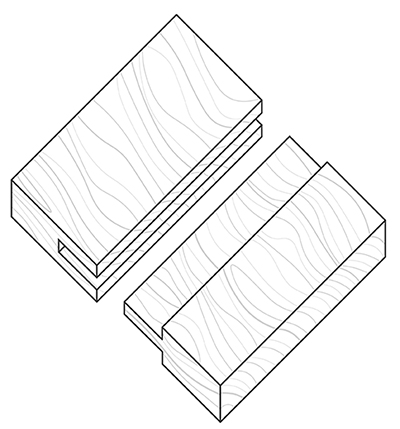
© Government of Canada, Canadian Conservation Institute. CCI 122428-0007
Figure 10. Tongue-and-groove joint.
turn-over edge (arête, fem., or arête de la toile, fem., or arête du châssis, fem.)
The edge of a painting where the canvas is turned over the auxiliary support (see Figure 1).
See also: tacking margin
twill pattern
See: twill weave
twill weave (armure sergé, fem.)
A complex weave that creates a diagonal pattern (see Figure 11).
Other term: twill pattern
See also: plain weave, warp1, weave, weft
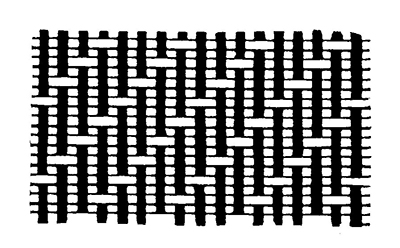
© Government of Canada, Canadian Conservation Institute. CCI 122428-0012
Figure 11. Twill weave.
varnish (vernis, masc.)
A solution of resin dissolved in a solvent, which dries to form a transparent film.
Note: Varnish is usually used as a final surface coating over a finished painting to even out the gloss, to saturate the colours and to protect the paint. The most common varnishes consist of natural resins such as mastic, dammar or copal. Recently, various synthetic resins have been used.
See also: surface coating
warp1 (chaîne, fem.)
The set of threads in a fabric that run parallel to the selvedge edge.
See also: plain weave, twill weave, weave, weft
warp2 (gauchissement, masc.)
A deformation, such as a bend or curve, in a rigid or semi-rigid material.
See also: deformation
wear (usure, fem.)
A change in the surface from the effects of abrasion.
See also: abrasion, rubbing, scraping, skinning
weave (armure, fem.)
The pattern created by the weft threads overlapping the warp threads in a woven fabric.
See also: plain weave, twill weave, warp1, weft
wedge
See: key
weft (trame, fem.)
The set of threads in a fabric that run at right angles to the selvedge edge.
See also: plain weave, twill weave, warp1, weave
white card
See: white cardboard
white cardboard (carton blanchi, masc., or carton blanc, masc.)
A paper-based board produced in various thicknesses, usually from multiple layers of paper fibres, which is normally used as a support for smaller paintings.
Other term: white card
wrinkles (plissement, masc.)
Puckers or ridges and furrows in a paint or varnish film that occurred during drying.
Bibliography
Buck, R.D. “Inspecting and Describing the Condition of Art Objects.” Museum Registration Methods. Washington, DC: American Association of Museums, 1979.
Conference on Comparative Lining Techniques. Handbook of Terms Used in the Lining of Paintings. London, UK: National Maritime Museum, 1974.
Gettens, R.J., and G.L. Stout. Painting Materials: A Short Encyclopaedia. New York, NY: Dover Publications, Inc., 1966.
Keck, C. A Handbook on the Care of Paintings. New York, NY: Watson-Guptill Publications, 1974.
Office québécois de la langue française. Le grand dictionnaire terminologique.
Philmore, E. A Glossary of Terms Useful in Conservation. Ottawa, ON: Canadian Museums Association, 1976.
Stout, G.L. “A Museum Record of the Condition of Paintings.” Technical Studies III, 4 (1935), pp. 200–212.
Bibliography for French-English Glossary
Adeline, J. Lexique des termes d’art. Paris, France: E Gründ, 1927.
Association française de normalisation (Afnor). Dictionnaire technique des peintures et des travaux de peinturage. Paris, France: Afnor, 1978.
Béguin, A. Dictionnaire technique de la peinture, 6 volumes. Paris, France: André Béguin, 1981–1984.
Béguin, A. Mémento pratique de l’artiste peintre. Brussels, Belgium: André Béguin, 1979.
Bergeon, S. Science et patience. Paris, France: Éditions de la Réunion des musées nationaux, 1990.
Bergeon, S., et C. Perier-D’Ieteren. "Typologie des altérations de surface de la couche picturale." In K. Grimstad, ed., 8th Triennial Meeting of the ICOM Committee for Conservation, Sydney, Australia, 6–11 September 1987: Preprints. Marina del Rey, CA: The Getty Conservation Institute, 1987, pp. 13–15.
Bergeon, S. Comprendre, Sauver, Restaurer [Exhibition catalogue]. Avignon, France: Musée du Petit Palais, 1976.
Binette, R. Vocabulaire des panneaux dérivés du bois : français-anglais. Québec, QC: Office de la langue française, 1985.
Bontinck, E. Physique et peinture. Brussels, Belgium: Éditions Lumière, 1944.
Conserver-restaurer [exhibition from 25 June to 28 October, 1975]. Museum of Grenoble, 1975.
De Henau, P. "Approche d’une terminologie descriptive de l’état de surface des matériaux pierreux." Bulletin de l’Institut Royal du Patrimoine Artistique 18 (1980–1981), pp. 170–182.
Émile-Mâle, G. La restauration des peintures de chevalet. Fribourg, Switzerland: Office du livre, 1976.
Garcia, P. Le métier du peintre. Paris, France: Dessain et Tolra, 1990.
Hours, M. Analyse scientifique et conservation des peintures. Fribourg, Switzerland: Office du livre, 1976.
Marette, J. Connaissance des primitifs par l’étude du bois. Paris, France: A. et J. Picard, 1961.
Marijnissen, R.-H. Dégradation, conservation et restauration de l’œuvre d’art, vol. 1 and 2. Brussels, Belgium: Éditions Arcade, 1967.
Petit, J. et H. Valot. Glossaire des peintures et vernis. Paris, France: Section française de l'Institut international de conservation, 1991.
Rostain, E. Rentoilage et transposition des tableaux, 2nd ed. Puteaux, France: EREC, 1987.
Sochoux, L. L’encadrement (Collection Connaissance et technique). Paris, France: Éditions Denoël, 1982.
French–English Index
abrasion (fem.) – abrasion
accrétion (fem.) – accretion
ampoule (fem.) – blind cleavage
arête (fem.), arête de la toile or arête du châssis (fem.) – turn-over edge
armure (fem.) – weave
armure sergé (fem.) – twill weave
armure toile (fem.) – plain weave
assemblage à mi-bois (masc.) – half-lap joint
assemblage à onglet (masc.) – mitre joint
assemblage à rainure et languette (masc.) – tongue-and-groove joint
assemblage à tenon et mortaise (masc.) – mortise-and-tenon joint
barre1 (fem.) or montant (masc.) – strainer bar
barre2 (fem.) – stretcher bar
biseau(masc.) or chanfrein (masc.) – bevel
blanchiment (masc.) or chanci (masc.) – blanching
bleuissement (masc.) – bloom
bord de la toile (masc.), bord de tension (masc.), bord non peint (masc.) or côté de la toile (masc.) – tacking margin
bordure de protection (fem.) – edge-strip
bosse (fem.) – bulge
carton blanchi (masc.) or carton blanc (masc.) – white cardboard
cartonnage (masc.) or facing (avoid, anglicism, masc.) – facing
carton toilé (masc.) – artist’s board
chaîne (fem.) – warp1
châssis à clés (masc.) – stretcher
châssis simple (masc.) – strainer
clé (fem.), clef (fem.) or coin (masc.) – key
clivage (masc.) – cleavage
cloque (fem.) – blister
composition (fem.) or composé du doreur (masc.) or mélange à mouler (masc.) or pâte anglaise (fem.) – compo
couche de protection (fem.) or couche protectrice (fem.) – surface coating
couche picturale (fem.) – paint layer
craquelure (fem.) – cracks
craquelure circulaire (fem.) – concentric cracks
craquelure de tension (fem.) – mechanical cracks
craquelure en diagonale (fem.) or craquelure d’angle (fem.) – diagonal cracks
craquelure en épi (fem.) or craquelure en arête de poisson (fem.) – feather cracks
craquelure en escargot (fem.) or craquelure en colimaçon (fem.) – spiral cracks
craquelure prématurée (fem.) or craquelure de séchage (fem.) – drying cracks
croisillon (masc.) or traverse (fem.) – cross bar
début de clivage (masc.) – incipient cleavage
déchirure (fem.) – tear
déformation (fem.) – deformation
dos protecteur (masc.) – backing board
écaillage (masc.) – flaking
éclat (masc.) – chip
empâtement (masc.) – impasto
encollage (masc.) or colle (fem.) – size
encrassement (masc.) – grime
enfoncement (masc.) – dent
entaille (fem.) – gouge
épidermage (masc.) or nettoyage excessif (masc.) – skinning
faïençage (masc.) – crazing
farinage (masc.) – chalking
fente (fem.) – split
feuillure (fem.) – rabbet
fissure (fem.) – check
frottement (masc.) – rubbing
gauchissement (masc.) – warp2
glacis (masc.) – glaze
gondolage (masc.) or ondulation (fem.) – cockling
grattage (masc.) – scraping
guirlande de tension (fem.) – tension garland
imprimatura (fem.) – imprimatura
incision (fem.) – cut
joint (masc.) – joint
joint abouté (masc.) – butt joint
joint à recouvrement (masc.) – lap joint
lacune (fem.) or manque (masc.) – loss
liant (masc.) or médium (masc.) – binder
lisière (fem.) – selvedge
marie-louise (fem.) – liner
marouflage (masc.) – marouflage
marque du châssis (fem.) – stretcher mark
mastic (masc.) or masticage (masc.) – fill
médium (masc.) – medium2
mesure à vue (fem.) – sight edge
panneau (masc.) – panel
panneau de bois aggloméré (masc.) – compressed wood board
panneau dur (masc.) – hardboard
parquetage (masc.) – cradle
peau de crocodile (fem.) or peau de crapaud (fem.) – alligator cracks
peinture (fem.) – paint
perforation (fem.) or trou (masc.) – puncture
pigment (masc.) – pigment
plaque de renfort (fem.) – mending plate
pli d’angle (masc.) – corner draws
plissement (masc.) – wrinkles
préparation (fem.), apprêt (masc.) or enduit (masc.) – ground
pulvérulence (fem.) – powdering
régler la tension de la toile (masc.) – key out
rentoilage (masc.) or doublage (masc.) – lining
rentoilage sur barres (masc.) – stretcher bar lining
repeint (masc.) or surpeint (masc.) – overpaint
repentir (masc.) – pentimento
retouche1 (fem.) – inpaint
retouche2 (fem.) – inpainting
saignement (masc.) – bleeding
saletés superficielles (fem., plur.) or salissure (fem.) – surface dirt
soulèvement (masc.) – lifting
soulèvement en cuvette (masc.) – cupping
soulèvement en tente (masc.) or frisure (fem.) – tenting
soulèvement en tuile (masc.) – buckling
support (masc.) or support principal (masc.) or support subjectile (masc.) – support
support auxiliaire (masc.) or support secondaire (masc.) – auxiliary support
support composite (masc.) – composite support
support rigide (masc.) – rigid support
toile (fem.) – canvas
toile de soutien (fem.) – loose lining
trame (fem.) – weft
usure (fem.) – wear
vernis (masc.) – varnish
vitrage (masc.) – glazing1
vitre de protection2 (masc.) – glazing2
CCI wishes to thank the Translation Bureau as well as the Centre de conservation du Québec for their assistance in creating this glossary.
Written by the Staff of the Fine Arts Section
Revised 2016
Originally published in 1994
Également publié en version française.
© Government of Canada, Canadian Conservation Institute, 2017
ISSN 1928-1455